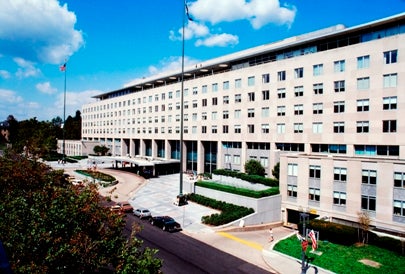In its never-ending efforts to be hip, the U.S. State Department last week launched a new Web site called “Discover Diplomacy.” It has video clips, it has audio tracks, it has interactive maps and images—it has it all.
The site is the work of the U.S. Diplomacy Center, an office in the Bureau of Public Affairs. But instead of being aimed at foreigners, it targets U.S. high school and college students as well as their professors, for whom the site is billed as a teaching tool.
Possibly due to the difficulty of getting foreigners to listen these days—even friendly governments nod and smile and ignore American policy—the State Department has decided to reach out to its domestic constituency. But wait: The State Department does not actually have a domestic constituency!
In fact, the State Department is prohibited by law from directing its communications to the American people, the law being the Smith–Mundt Act of 1948. Secretary of State Madeleine Albright, who was hand-picked by then-First Lady Hillary Clinton to be President Clinton’s Secretary of State, undertook a similar educational campaign (though without the aid of interactive Web sites) and was stopped in her tracks by Congress. There is a real question here: Does Smith–Mundt permit the State Department to proselytize among American students via the Internet?
Much has been written about the Smith–Mundt Act, which is unique in the world. With the possible exception of Japan, no other country has a law prohibiting their foreign relations departments from addressing their own people at home, and indeed some foreign diplomats find it bizarre.
Yet, as much as Smith–Mundt hampers the work of State Department officials and sometimes Pentagon officials, and much as it annoys the directors of U.S. International Broadcasting, whose products cannot be shown domestically, it is still the law of the land. Many believe it is time for its repeal, yet the legislation has yet to be written to make it happen.
Meanwhile, the Discover Diplomacy site is a mixed bag. Its headline banner suggests that touring basketball teams and American jazz (both solid components of U.S. public diplomacy) have done as much for the world as NATO summits or ceasefire negotiations with North Korea. And the site’s interactive map, which highlights “people, places and issues” seems random. It appears, for instance that we have no issues in the Middle East or North Africa and that the only issue we have with China is “fisheries.”
As indicated elsewhere on the map, though, American diplomats delve into such topics as women’s rights, food security, water security, Internet freedom, religious freedom, counterterrorism, counter-narcotics, intellectual propriety rights, and human trafficking. This is not your father’s State Department.
Also, among the notable diplomats highlighted on the global map, out of eight, four are African-American. If the idea here is to celebrate diversity, the State Department has failed impressively. Indeed, no other minority group is represented. Have there been no U.S. ambassadors of Asian, Hispanic, or Jewish origin?
Meanwhile, the sections on the functions of embassies, consulates, diplomats, “Who Practices Diplomacy?,” etc., are fairly informative and written at roughly high school level, and they could be considered suitable teaching tools. And video clips of U.S. diplomats giving speeches about their fields are not without interest—if you like to watch officials giving speeches.
But beyond questions of the content, which could be improved, the questions have to be asked: Is this what the State Department should be doing with its resources? And does the law allow it?
